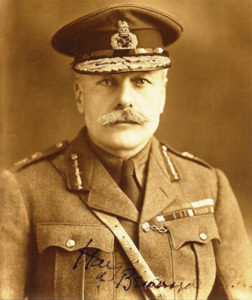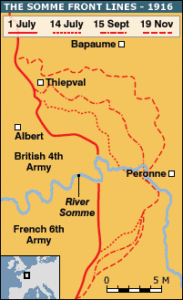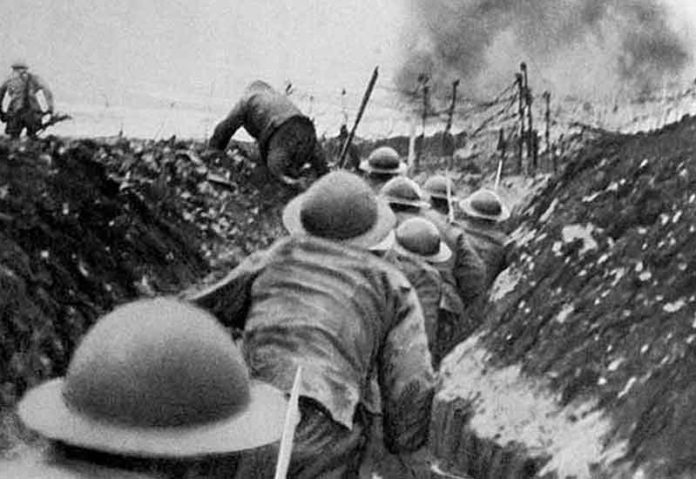 Exactly 100 years ago perhaps the best-known battle of the First World War began. It has become the symbol of the stupidity and destructiveness of the war. Starting in July 1916 the allied armies- mostly British- tried to break through the German line around the River Somme. Not until November- with around 1 Million men in total killed and wounded- did General Haig, the Commander in Chief of the British armies in France, give up the attempt.
Exactly 100 years ago perhaps the best-known battle of the First World War began. It has become the symbol of the stupidity and destructiveness of the war. Starting in July 1916 the allied armies- mostly British- tried to break through the German line around the River Somme. Not until November- with around 1 Million men in total killed and wounded- did General Haig, the Commander in Chief of the British armies in France, give up the attempt.
The First Day of the Somme- 1st July- was the worst day of the offensive. Within an hour some 30,000 British soldiers were dead or injured, and by the end of the day there were 60,000 British casualties, 20,000 of them dead. And all along the Front Line, the British were back where they started. They had totally failed to achieve any of their objectives. July 1st 1916 holds the dubious honour of having the most soldiers killed in a single day in the History of Britain. And five months later, when Haig finally called off the attacks, the British had just about reached the place they were supposed to get to on that first day.
Haig had started with such high hopes. He fully expected to break through the German lines within a few days, sweep the Germans out of France and win the war within a few weeks. So what went wrong? And how much of the blame for the failure of the battle lies with Haig himself?
With the benefit of hindsight it is not difficult to see that the plan was deeply flawed from the start. Haig had little choice about attacking. He had plenty of men- those hundreds of thousands who had volunteered so eagerly when they saw those “Your Country Needs You” posters in 1914- and neither his army nor the public at home would have understood if he had decided not to use them. The Germans had conquered large areas of France; therefore the allies had to keep attacking to get them out. Nor did Haig have much choice about his method of attack- a frontal assault on German trenches. Since the trenches ran all the way from the English Channel to Switzerland, there was no chance of an outflanking attack. So the soldiers would have to walk across No Man’s Land and attack the trenches in front of them.
 Haig thought that a massive artillery bombardment- in the last hour alone 200,000 shells were fired- would kill most of the Germans, destroy the barbed wire, and the survivors would be so dazed they would surrender at once. British soldiers were told to walk slowly to the German trenches where they would find thousands of dead Germans.
Haig thought that a massive artillery bombardment- in the last hour alone 200,000 shells were fired- would kill most of the Germans, destroy the barbed wire, and the survivors would be so dazed they would surrender at once. British soldiers were told to walk slowly to the German trenches where they would find thousands of dead Germans.
It was a fantasy. Too many of the shells were the wrong kind or duds. The barbed wire was not cut and the Germans were safe in their deep concrete shelters. As soon as the bombardment stopped, they returned to the trenches, manned their machine-guns and massacred the thousands of British walking slowly towards them.
Haig had promised he would call off the attack if it failed- but misled by Brigadier Charteris, his Chief of Intelligence, that the German army was on the point of collapse, he persisted in his attacks. This is a major criticism of Haig. He had personally appointed and promoted Charteris- an officer who had no previous experience of Intelligence- because he was an optimist who always told Haig what he wanted to hear.
Other mistakes can be briefly listed. The Generals vastly overrated the damage the shells would do, and by insisting the men walk slowly and without thinking for themselves doomed thousands to their deaths. By contrast the German army encouraged individual soldiers to use their own initiative and make their own decisions. Unfortunately Haig did not trust his new army of enthusiastic volunteers.
 Haig never understood the problems the ordinary soldiers faced. He never visited the Front Line. This was the right decision during the actual battle- had he gone to one part of the battlefield he would not have been able to control the rest of the battle- but it remains a damning criticism of Haig that even when there was little fighting going on, he never once went to see a frontline trench to understand the conditions his men were fighting in.
Haig never understood the problems the ordinary soldiers faced. He never visited the Front Line. This was the right decision during the actual battle- had he gone to one part of the battlefield he would not have been able to control the rest of the battle- but it remains a damning criticism of Haig that even when there was little fighting going on, he never once went to see a frontline trench to understand the conditions his men were fighting in.
Haig had no choice about attacking in 1916, nor in the method of his attack. But by appointing and trusting Charteris and persisting in the Battle when it had clearly failed, he was responsible for the deaths of thousands of his own men.









